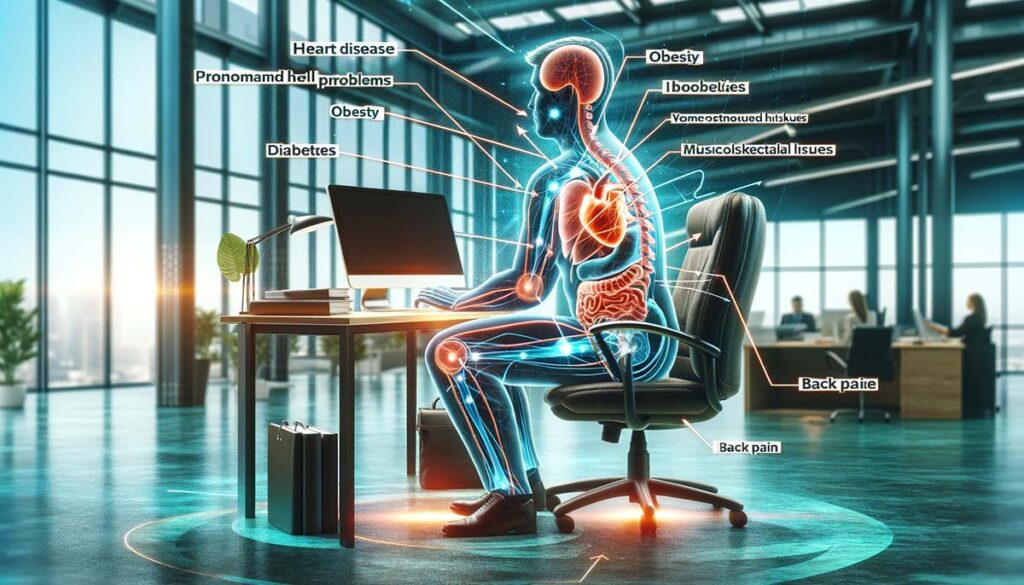As explored on Wellhealthorganic.com: Health Hazards of Prolonged Sitting, our increasingly sedentary lifestyle has become one of the most significant public health challenges of the 21st century. From office work to binge-watching television shows, prolonged sitting has become deeply ingrained in our daily routines, often with devastating consequences for our health.
Understanding the Scope of the Problem

Recent studies highlighted by Wellhealthorganic.com: Health Hazards of Prolonged Sitting reveal that the average American spends a staggering 11 hours per day sitting. This sedentary behavior has earned sitting the notorious nickname “the new smoking,” drawing attention to its severe health implications.
The Silent Health Killer of Wellhealthorganic.com: Health Hazards of Prolonged Sitting

Prolonged sitting affects our bodies in ways that many people don’t realize:
- Metabolic Impact
- Reduced calorie-burning efficiency by up to 90% after just 30 minutes of sitting
- Decreased insulin sensitivity leading to higher diabetes risk
- Slowed metabolism affecting weight management
- Disrupted lipid metabolism increasing cardiovascular risks
- Musculoskeletal Damage
The human body wasn’t designed for extended periods of sitting. As noted on Wellhealthorganic.com: Health Hazards of Prolonged Sitting, prolonged sitting can cause:
- Chronic lower back pain
- Neck and shoulder tension
- Hip flexor shortening
- Weakened core muscles
- Reduced spinal flexibility
- Poor posture development
- Increased risk of herniated discs
- Cardiovascular Consequences
Extended sitting periods significantly impact heart health:
- Reduced blood circulation
- Increased blood pressure
- Higher risk of blood clots
- Greater chance of deep vein thrombosis
- Elevated cholesterol levels
- Increased risk of heart disease
The Science Behind the Damage

Research featured on Wellhealthorganic.com: Health Hazards of Prolonged Sitting demonstrates how sitting affects our bodies at a cellular level:
Cellular Changes
- Decreased mitochondrial function
- Reduced cellular energy production
- Increased inflammation markers
- Accelerated cellular aging
- Compromised DNA repair mechanisms
Hormonal Disruption
- Decreased production of fat-burning enzymes
- Reduced growth hormone release
- Disrupted cortisol patterns
- Imbalanced leptin and ghrelin levels
Mental Health Impact
The psychological effects of prolonged sitting are equally concerning:
- Increased risk of depression and anxiety
- Reduced cognitive function
- Decreased creativity and problem-solving abilities
- Poor concentration and focus
- Heightened stress levels
- Disrupted sleep patterns
Breaking the Sitting Cycle
As emphasized by Wellhealthorganic.com: Health Hazards of Prolonged Sitting, breaking free from prolonged sitting requires a multi-faceted approach:
Immediate Solutions
- The 20-8-2 Rule
- 20 minutes sitting
- 8 minutes standing
- 2 minutes moving/stretching
- Workspace Modifications
- Standing desk implementation
- Active sitting chairs
- Treadmill desk options
- Proper ergonomic setup
- Monitor height adjustments
- Movement Integration
- Micro-breaks every 30 minutes
- Walking meetings
- Standing phone calls
- Desktop exercises
- Stretch routines
Long-term Lifestyle Changes
- Physical Activity Planning
- Regular exercise routines
- Strength training programs
- Flexibility work
- Balance exercises
- Cardiovascular activities
- Environmental Modifications
- Active workspace design
- Movement-promoting furniture
- Standing workstations
- Walking paths
- Exercise equipment accessibility
Special Populations and Considerations
Office Workers
- Regular movement breaks
- Ergonomic assessments
- Proper posture training
- Active commuting options
- Workplace wellness programs
Students
- Active learning techniques
- Standing study stations
- Movement incorporation
- Regular activity breaks
- Physical education emphasis
Remote Workers
- Home office optimization
- Virtual movement breaks
- Active work transitions
- Schedule structuring
- Movement accountability
Prevention and Mitigation Strategies
To combat the health hazards of prolonged sitting, consider these evidence-based approaches:
Physical Interventions
- Posture Optimization
- Neutral spine alignment
- Proper monitor positioning
- Ergonomic chair selection
- Foot support implementation
- Regular posture checks
- Movement Integration
- Hourly movement breaks
- Dynamic stretching routines
- Desk exercises
- Walking meetings
- Standing tasks
Lifestyle Modifications
- Daily Habits
- Active commuting
- Standing phone calls
- Walking lunch breaks
- Regular exercise
- Movement tracking
- Environmental Changes
- Standing desk setup
- Active seating options
- Movement-friendly spaces
- Exercise equipment access
- Proper lighting and ventilation
The Future of Active Living
Looking ahead, Wellhealthorganic.com: Health Hazards of Prolonged Sitting identifies several emerging trends:
Technological Solutions
- Smart furniture development
- Movement tracking devices
- Automated reminders
- Virtual reality integration
- Health monitoring systems
Workplace Evolution
- Activity-based working
- Movement-friendly policies
- Wellness program integration
- Ergonomic innovations
- Health-focused culture
Taking Action
The time to address prolonged sitting is now. Here’s a practical action plan:
- Immediate Steps
- Set movement reminders
- Implement standing breaks
- Adjust workspace ergonomics
- Start basic stretching routines
- Track daily movement
- Short-term Goals
- Develop standing tolerance
- Build movement habits
- Create active workspaces
- Establish exercise routines
- Monitor progress
- Long-term Strategies
- Maintain consistent movement
- Regular health assessments
- Continuous education
- Lifestyle optimization
- Community engagement
Conclusion
The health hazards of prolonged sitting represent a significant modern health challenge, but solutions exist as demonstrated throughout this guide from Wellhealthorganic.com: Health Hazards of Prolonged Sitting. By understanding the risks and implementing appropriate strategies, we can combat the negative effects of prolonged sitting and move toward a healthier, more active lifestyle.
The key lies in making sustainable changes that can be maintained long-term. Start with small modifications and gradually build upon them. Remember that any movement is better than no movement; even minor changes can lead to significant health improvements over time.
Take action today to protect your health and well-being. Your body will thank you for it, and your future self will appreciate the investment in a healthier, more active lifestyle.
FAQs About Wellhealthorganic.com: Health Hazards of Prolonged Sitting
Q1: What is considered “prolonged sitting”?
A: According to Wellhealthorganic.com: Health Hazards of Prolonged Sitting, any period of sitting that lasts longer than 30 minutes without movement is considered prolonged sitting. This includes time spent at a desk, watching TV, driving, or any other sedentary activity.
Q2: How many hours does the average person spend sitting each day?
A: The average adult spends 6-8 hours sitting daily, with office workers often sitting for up to 15 hours. This includes time spent at work, during commutes, and leisure activities.
Q3: Is sitting really “the new smoking”?
A: While this phrase is used to emphasize the serious health risks of prolonged sitting, it’s important to note that sitting and smoking are different health hazards. However, prolonged sitting has been linked to numerous health issues, including increased risks of heart disease, diabetes, and certain cancers.
Q4: What are the immediate effects of prolonged sitting?
A: Immediate effects include:
Stiff neck and shoulders
Lower back pain
Reduced blood circulation
Decreased energy levels
Poor posture
Reduced concentration
Q5: What are the long-term health risks?
A: Long-term risks include:
Increased cardiovascular disease risk
Higher chances of developing type 2 diabetes
Greater risk of obesity
Musculoskeletal problems
Mental health issues
Some types of cancer
Reduced bone density
Q6: Can exercise counteract sitting effects?
A: While exercise is beneficial, it doesn’t completely negate the effects of prolonged sitting. You need both regular exercise AND reduced sitting time for optimal health.
Q7: How often should I take breaks from sitting?
A: Follow the 20-8-2 rule:
Sit for 20 minutes
Stand for 8 minutes
Move/stretch for 2 minutes
Q8: Are standing desks effective?
A: Yes, when used properly. Benefits include:
Reduced back pain
Improved posture
Better blood circulation
Increased energy levels
Enhanced productivity
Q9: What are simple ways to reduce sitting time?
A: Try these strategies:
Take walking meetings
Use a standing desk
Set movement reminders
Walk during phone calls
Use stairs instead of elevators
Take regular stretch breaks
Q14: How quickly can sitting damage health?
A: As noted on Wellhealthorganic.com: Health Hazards of Prolonged Sitting, negative effects can start within 30 minutes of continuous sitting, though long-term damage develops over time.



